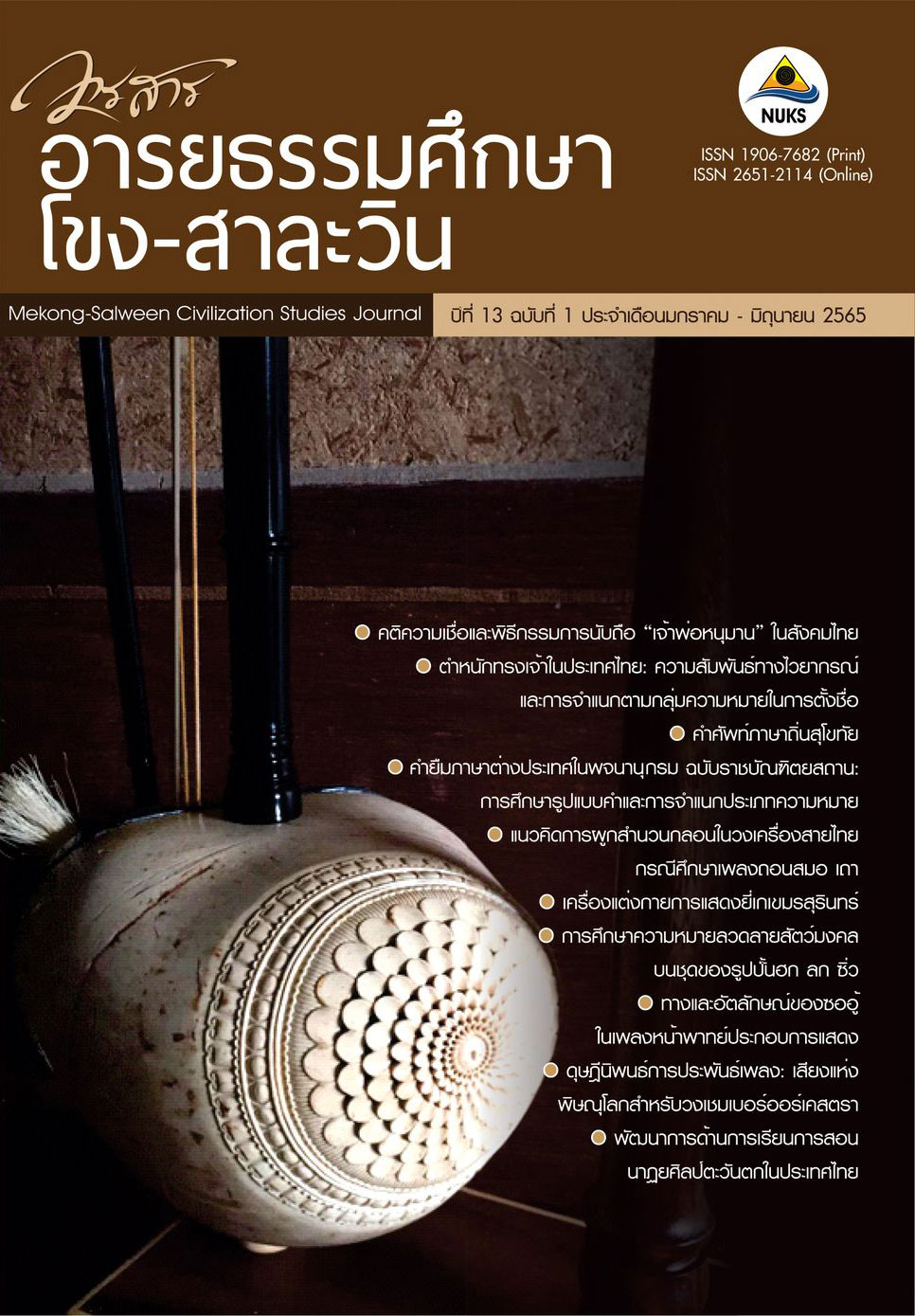คติความเชื่อและพิธีกรรมการนับถือ “เจ้าพ่อหนุมาน” ในสังคมไทย คติความเชื่อและพิธีกรรมการนับถือ "เจ้าพ่อหนุมาน" ในสังคมไทย
Main Article Content
บทคัดย่อ
บทความวิจัยนี้มุ่งศึกษาคติความเชื่อและพิธีกรรมการนับถือเจ้าพ่อหนุมานในสังคมไทย โดยเก็บข้อมูลภาคสนาม ช่วง พ.ศ. 2562-2564 วิเคราะห์และตีความข้อมูลตามแนวคิดทฤษฎีทางคติชนวิทยา ผลการวิจัยพบว่า ศาลเจ้าพ่อหนุมานเท่าที่พบในปัจจุบันมีจำนวน 8 แห่ง ได้แก่ 1. ศาลเจ้าพ่อกำแหงหนุมาน เขตตลิ่งชัน กรุงเทพฯ 2. ศาลเจ้าพ่อหนุมาณ เขตจอมทอง กรุงเทพฯ 3. ศาลหลวงพ่อหนุมาน จังหวัดสมุทรสงคราม 4. ศาลสมเด็จพระองค์ท่านหนุมาน จังหวัดกาญจนบุรี 5. ศาลเจ้าหนุมาน จังหวัดเพชรบุรี 6. ศาลเจ้าพ่อหนุมาน จังหวัดประจวบคีรีขันธ์ 7. ศาลเจ้าพ่อหนุมาน (หนองหนุมาน) จังหวัดปราจีนบุรี และ 8. ศาลเจ้าพ่อหณุมาน (แควหนุมาน) จังหวัดปราจีนบุรี สะท้อนถึงความเชื่อถือตัวละครหนุมานจากเรื่องรามเกียรติ์ในฐานะ “สิ่งศักดิ์สิทธิ์” ของคนในภูมิวัฒนธรรมภาคกลาง ผู้วิจัยยังพบว่าที่มาของความเชื่อแบ่งได้เป็น 6 กลุ่ม คือ 1. ความเชื่อเรื่องลิงเจ้าที่ 2. ภูมินามของสถานที่ที่เกี่ยวกับตัวละครหนุมาน 3. รูปแกะสลักในฐานะวัตถุศักดิ์สิทธิ์ลอยน้ำมา 4. ปูนปั้นรูปหนุมาน 5. ร่างทรงเจ้าพ่อหนุมาน และ 6. ความเชื่อเรื่องทหารบริวารของเจ้าพ่อพระราม-พระลักษณ์ พิธีกรรมการนับถือเจ้าพ่อหนุมานสื่อถึงการบวงสรวง “ผีอารักษ์” บนพื้นฐานความเชื่อดั้งเดิม พุทธศาสนา คติพราหมณ์ และธรรมเนียมจีน
Downloads
Article Details

อนุญาตภายใต้เงื่อนไข Creative Commons Attribution-NonCommercial-NoDerivatives 4.0 International License.
เอกสารอ้างอิง
Amornwanitsak, S. (2016). Chaopho Khaotok: The Thai Guardian Angel that Became a Chinese God. International Journal of East Asian
Studies, 20(2), 1-21.
Jeennoon, P. (2004). An Analysis of Hunuman in Various Versions of The Ramakien (Master’s Thesis). Silpakorn University, Nakhon
Pathom.
Jirapas, J. (2004). Heng Chia: From Literature to Monkey God. Bangkok: Matichon.
Kabin Sub-district Municipality. (2007). 50 years of Kabin Sub-district Municipality. Prachinburi: Ban Punam.
Nathalang, S. (2012). Village and City Guardian Spirits Persistence of Belief and Ritual Concerning Guardian Spirits in Current Thai-Tai
Societies. Journal of Thai Studies, 8(1), 41-68.
Nimmanahaeminda, P. (2003). The Story of Rama in Tai Societies. Ramayana Symposium. Conference Report of the Story of Rama,
Ramayana, Ramakien at Chulalongkorn University, Bangkok.
Onura, N. (2019, December 25). Interviewed by Rattanaphon Chuenka [tape recording]. Yisan District, Samut Songkhram.
Puriwanchana, S. (2005). The Characteristics of Mythical Legend of Riverine and Coastal Areas in Central Thailand (Master’s Thesis).
Chulalongkorn University, Bangkok.
Sathienkoses. (1952). The Instrument of Ramakien. Bangkok: Fine Arts Department.
Songsiri, W. (2001). The Myth and Ritual of Khun Phu Sriracha: Reflection on The Socio-Cultural Integration in Yisan Village (Master’s
Thesis). Silpakorn University, Bangkok.
Thaihom, M. (2020, March 21). Interviewed by Rattanaphon Chuenka [tape recording]. Taling Chan District, Bangkok.
The First Infantry Battalion, Infantry Center. (2014). Commemorative of The Founding of The First Infantry Battalion, Infantry Center.
Prachuap Khirikhan: The First Infantry Battalion, Infantry Center.
Wisessaeng, J. (2020, December 19). Interviewed by Rattanaphon Chuenka [tape recording]. Chomthong District, Bangkok.
Wolcott, Leonard T. (1978). Hanuman: The Power-Dispensing Monkey in North Indian Folk Religion. Journal of Asian Studies, 37(4), 653-


